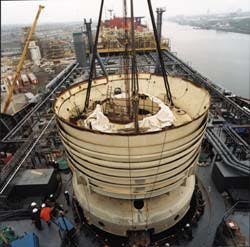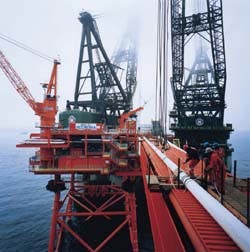Drilling progress speaks volumes for cash-minded North Sea operators
Preparatory work on Shell's Anasuria FPSO prior to sailout to the central North Sea.
Stock-taking has been on the minds of most North Sea operators this year. Modest returns from exploration are almost a non-issue: activating dormant discoveries is seen as the way forward.
Downwardly mobile development prices are not the main driver behind the spate of new projects. Although cost-saving committees such as Crine and Norsok may like to take the credit, technology is the real hero.
A report by UK energy analysts Smith Rea on `The Economic Impact of New Drilling Technologies' points out that underbalanced drilling, multilaterals and the like are not new: their antecedents often trace back to the 1980s. What is new, says the analysts, is "the needs-driven 1990s which have seen a breakthrough in capability and application".
Smith Rea estimates the new techniques trimmed £1 billion off the costs of North Sea projects between 1990 and 1995. This is minor fare compared to their impact over the same period on increasing recoverable reserves within existing fields, and developing new fields which would otherwise have been unexploitable. Resultant extra production, totaling 4.8 billion bbl, is equivalent to £54 billion, Smith Rea points out - much of it flowing in by the end of this decade.
Among the showcase fields for these new technologies is Norsk Hydro's Troll Oil development in the Troll West gas province, where up to 15 multilateral wells are planned, and Texaco's Captain Field, where all the wells will be horizontal.
Heeremac handled the recent installation of the budget-price Valhall wellhead platform.
Exploration disappoints
In exploration, the picture is less rosy, except in Norway where all northern Europe's key discoveries have come this year. In fact, Norwegian exploratory well numbers from January to June were down from 16 to 12 against the corresponding period in 1995. However, four of this year's wells yielded good results compared with one in the previous first half.
The biggest looks to be Saga's gas/condensate south-west of Smorbukk. Appraisal work suggests reserves of 2 tcf and 120MM bbl, with a soon-to-be-ready made export outlet, now that the Aasgard development and pipeline has been approved. In the Fram area north of Troll, Norsk Hydro made two discoveries estimated at 130MM bbl and 450 bcf of gas (combined). Finally, Statoil located a new pocket of gas east of Gullfaks.
Britain's reliable southern gas basin threw up a gas find for Ranger north of its Anglia development, but there were no surprises elsewhere on the oil front. Off the Netherlands, where exploration has picked up from the low of recent years, Occidental, Elf and NAM all had minor triumphs finding new gas.
Despite the low exploration yields, this is not a bad period for drilling contractors, according to Mackay Consultants in Scotland. They forecast a steady rise in exploration and appraisal wells off northwest Europe, peaking at 147 next year and only tailing off slightly in 1998. North Sea dayrates are high, due mainly to the shortage of rigs worldwide. Oil companies are responding by securing rigs on longer-term contracts.
Motives vary across the three drilling disciplines. In higher risk exploration acreage, operators are teaming up to alternate the same rig. For instance, a group of Irish Sea operators are taking the Glomar Adriatic X1 in strict rotation for a series of short exploration wells this year. The license areas are close together, which cuts rig mobilization costs.
Other operators with ambitious development projects are contracting rigs for sustained periods of development drilling: Aasgard, for instance, could require 60 subsea development wells. The third category, the appraisers, are hiring semis for extended well tests to assess reservoir producibility.
These can vary from a few months, as in the current cases of Norsk Hydro's Hermod and Ranger's Pierce tests, to two years for the recently completed Machar early production program. It took that long for BP to decide that the 60MM bbl reservoir, a fractured chalk structure, could be tapped successfully using waterflooding: Machar is a key component of the multi-field ETAP development in the UK Central North Sea.
Norway develops
UK analysts Wood Mackenzie list 21 current or probable new field developments off Norway, with combined reserves of 4.3 billion bbl of oil/NGLs and 49 tcf of gas. Total investment could be around $25 billion, which also covers two long gas pipelines from Aasgard in Haltenbanken to western Norway, and the NorFra line from the Draupner platform to Dunkerque, France.
With Aasgard joining Norne and Njord for development, capex for mid-Norway could account for 27% of the Norwegian total between now and 2000. In the Norwegian North Sea, several mid-size developments are under way close to existing developments, such as Oseberg East, with others expected soon such as Oseberg South and Brage Sognefjord. The biggest redevelopments/field extensions are at Ekofisk and Troll.
This activity is being encouraged by rising cash flow amongst the Norwegian operators, driven by higher production and an expected plunge in capex from 1998 onwards. Wood Mackenzie also forecasts average opex on the Norwegian shelf this year of $4.5/boe, down 30% from 1991 when CO2 tax was introduced. CO2 costs today account for 5% of total Norwegian opex.
Norsok's cost-cutting initiatives are paying off in the new generation of low-cost satellite developments such as Vigdis and Tordis East; but standalone projects like Njord and Balder also look to have comparatively low operating costs.
A shining example for Norsok aficionados is Amoco's new Valhall wellhead platform. This came onstream in June, just one year after the PDO was approved, with expenditure trimmed from an anticipated NKr2.1 billion to NKr1.5 billion by the time of first oil. Construction and installation of the 19-well slot platform, by Heerema Tonsberg and Heeremac, took a mere 10 months.
The new platform will raise oil production at Valhall by 40,000 b/d to 125,000 b/d by the end of 1998. A new technique is being employed to enhance production from the wells, which are horizontal and fairly long. Several producing layers are being fractured, then filled with sand to keep them open: this could in fact increase well costs, but that would be offset by the rewards from increased production.
Floaters bobbing along
Ocean Consultants reported recently that of the 24 new FPSO vessels under construction or planned for world markets, two-thirds were destined for the North Sea area. In Norway, Norsk Hydro and Esso could swell the ranks further by opting for floaters for the Fram and Jotun Fields.
There is something of a competition currently over whose vessel will be cheapest. Saga claimed the Varg monohull, under construction at FELS, would have the lowest overall cost among North Sea production ships (NKr1.6 billion), and the lowest cost per barrel of daily processed oil. Statoil countered that the Aasgard vessel was more economic than either Varg or the Norne ship as regards daily oil and gas production costs.
Varg might be cheaper in simple purchase terms, it added, but production capacity was less than a quarter of Aasgard's 49,000 cubic meters a day. Norne, meanwhile, looks set to come in NKr3 billion below the original NKr11.4 billion estimate, despite delays to construction of the hull.
In the UK, tanker conversions are expected to produce smaller marginal fields such as Conoco's Boulton and Buckland and possibly Kerr-McGee's Janice. But semi Chris Chenery seems to be Texaco's choice for the Galley oilfield, with storage outlawed in favor of a pipeline to a nearby processing platform. Vessels generally seem to be the easier option for small UK reservoirs, with semis mostly tied up on drilling.
In the central North Sea, Shell's Teal, Teal South and Guillemot A Fields are about to be produced by the Anasuria, claimed to be the biggest FPSO in the North Sea with 850,000 bbl storage capacity. But that record will go in 1998 when the 900,000 bbl storage of the Schiehallion ship comes into play. This is the second major oilfield development west of the Shetlands.
Schiehallion, 100 miles west of Orkney and Shetland, extends across five separate blocks in 375 meters of water. Total reserves are 340MM bbl, including the 85MM bbl estimated for the Loyal satellite seven km to the north: the latter was discovered in autumn 1994 through a sidetrack of a wildcat in block 204/20.
The project, priced at £900 million, will center around 29 subsea wells in four clusters, with oil flowing to an FPSO vessel through subsea flowlines and flexible risers. The vessel will be stationed permanently on the field with shuttle offtake of oil every four to six days. Associated gas will likely be reinjected into a separate structure called An Teallach, close to the Foinaven Field. VOC emissions will also be limited through use of a displaced gas recycling system when transferring produced oil to shuttle tankers.
BP will have to step up its watch on environmental action groups, which are opposed to winter production in an area remote from oil spill response. BP tried to allay these fears in May by staging a mock-collision between a merchant vessel and a shuttle tanker en route from the Foinaven Field to the Flotta oil terminal. Then the interactive response capability of the various oil spill organizations was demonstrated, as well as BP's ability to mobilize extra equipment from the UK mainland to Shetland.
Partly to forestall further criticism, 14 oil companies have funded a new survey of the seabed west of Shetland and its related environments. Research vessel Charles Darwin has been criss-crossing the area equipped with a multicorer for collecting sediment samples and a time lapse photography system for long-term monitoring of the seabed. Any sensitive habitats identified will be subject to further investigation, with the results influencing future UK regulatory data for the area.
Copyright 1996 Offshore. All Rights Reserved.


